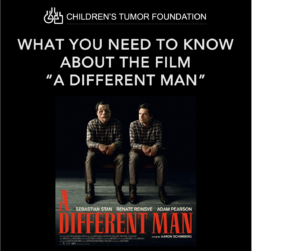With the release of the film, A Different Man, directed by Aaron Schimberg and produced by A24, the genetic condition neurofibromatosis type 1 (NF1) is getting attention from film reviewers and moviegoers alike.
 A Different Man tells the fictional story of Edward (played by well-known actor Sebastian Stan), a man with a facial difference who is asked to join an “experimental drug trial that could heal you.” When that trial does, indeed, cause his face to transform, the film follows Edward’s experiences with his “new” appearance. However, he soon becomes fixated on an actor in a stage production based on his former life. Adam Pearson, a real-life actor with NF1, plays Oswald, this stage actor, bringing meta-theatricality to a story that touches on themes of identity, self-perception, and physical appearance. Pearson is a well-known actor who often speaks about his diagnosis of NF1; he previously appeared in Under the Skin alongside Scarlett Johansson, among other projects.
A Different Man tells the fictional story of Edward (played by well-known actor Sebastian Stan), a man with a facial difference who is asked to join an “experimental drug trial that could heal you.” When that trial does, indeed, cause his face to transform, the film follows Edward’s experiences with his “new” appearance. However, he soon becomes fixated on an actor in a stage production based on his former life. Adam Pearson, a real-life actor with NF1, plays Oswald, this stage actor, bringing meta-theatricality to a story that touches on themes of identity, self-perception, and physical appearance. Pearson is a well-known actor who often speaks about his diagnosis of NF1; he previously appeared in Under the Skin alongside Scarlett Johansson, among other projects.
We recognize the value of bringing NF into the public eye, and we congratulate Adam Pearson on his compelling performance in this film. NF affects over 4 million people worldwide, and while the condition can sometimes result in disfigurement, this is just one aspect of a much larger and more diverse experience. Therefore, we want to ensure that the conversation around this film does not cause confusion about NF1.
While the film has drawn some positive critical attention for its quirky, arthouse style, its dark, disturbing content may not align with audience expectations, particularly within the NF community. For individuals with NF, the film could be triggering, though some may find it cathartic depending on their personal experiences. The film touches on issues of self-identity and emotional struggles, but is not a documentary. While it’s not the most graphic film ever made, there are several intense scenes. The movie is Rated R, for gore, nudity, and violence. It is definitely not for families/kids.
While NF1 can sometimes result in disfigurement, as Pearson has experienced, it is a rare manifestation of NF, which has a far more diverse experience. Some individuals with NF1 experience cognitive challenges, learning disabilities, chronic pain, the growth of internal tumors that can affect organ function, vision, or hearing, or external tumors on the skin throughout the body. It is important to note that the majority of individuals with NF1 do not experience pronounced physical changes.
We invite everyone to learn more about NF – its various manifestations, the ongoing research for better treatments, and the daily experiences of those affected. The Children’s Tumor Foundation is at the forefront of this effort, driving forward more solutions, better options, and faster results for all NF patients.
The NF community may be wondering if they should see the film. While we’re not film critics, we feel it’s our responsibility to provide the facts and caution viewers, especially given its R rating and disturbing content. It’s been described as a dark comedy, which may not resonate the same way for those with NF. For those who enjoy these kinds of films, it might offer a thought-proving experience. In order to make a decision, please read on for key facts and considerations:
Understanding the Film vs. Reality
 While the film never actually mentions the words “NF” or “neurofibromatosis”, the media reviews have made mention of NF1. It’s important to understand that the experience portrayed by Sebastian Stan is fictional, in particular the “treatment” he undergoes, which to put it in no uncertain terms, is absurdly ridiculous. So keep that in mind if you go to see the film – you are watching Hollywood fiction.
While the film never actually mentions the words “NF” or “neurofibromatosis”, the media reviews have made mention of NF1. It’s important to understand that the experience portrayed by Sebastian Stan is fictional, in particular the “treatment” he undergoes, which to put it in no uncertain terms, is absurdly ridiculous. So keep that in mind if you go to see the film – you are watching Hollywood fiction.
It’s important to note, again, that the “treatment” featured in the movie is fake. In reality, significant progress has been made in NF treatments, with the Children’s Tumor Foundation leading the charge. CTF played a pivotal role in the development and approval of Koselugo, the first FDA-approved drug for some NF1-related tumors. Beyond that, we are propelling the field forward by supporting additional promising treatments, including mirdametinib, which is currently awaiting FDA approval, and NFX-179 topical gel, which is in Phase 3 trials. We are also advancing innovative projects like an NF biomarker study, which through a simple blood test aims to predict tumor behavior and improve early detection of cancer, and the development of brigatinib for NF2-SWN, recently published in the New England Journal of Medicine. As these treatments and others move forward, we continue to push for even more options, faster results, and greater awareness, ensuring that NF patients benefit from every breakthrough and that the world understands the urgency to act.
Therefore, it’s crucial to distinguish the dramatic portrayal on the silver screen from the diverse and often misunderstood reality that most individuals with NF1 experience. At CTF, we’re here to set the record straight.
Is A Different Man About NF1?
No. While the film includes Pearson, an actor who, in real life, is known to have a diagnosis of NF1, it’s important to understand that A Different Man is not about NF1. The characters portrayed by Stan and Pearson are identified as individuals with facial differences, but the film does not explore the condition or cause of these differences. In fact, scenes in which medical professionals are observing and treating Stan’s character, and his subsequent transformation, his condition does not seem to be a tumor-predisposition syndrome at all. In addition to Edward and Oswald, there is a sequence in the film that includes 5 or 6 other individuals with facial differences. The medical cause of these differences is not explored, and has been intentionally left out of the film for artistic reasons.
What is Neurofibromatosis Type 1?
Neurofibromatosis type 1, or NF1, is a genetic condition that can cause tumors to grow on nerves throughout the body and is most often diagnosed in childhood. Contrary to the film’s portrayal, the majority of individuals with NF1 have mild symptoms, and many may not even realize they have the condition at all. Each case of NF is unique.
Common Questions from Viewers
What is Adam Pearson’s condition?
Pearson’s facial disfigurement is caused by the genetic condition neurofibromatosis type1. Interestingly, Pearson’s twin brother, Neil Pearson, also lives with NF1 but does not experience disfigurement. Neil instead experiences cognitive and memory challenges, highlighting how NF1 impacts individuals in different ways.
Is this Elephant Man Syndrome?
No, Adam Pearson does not have Elephant Man Syndrome; he lives with a condition called neurofibromatosis type 1, or NF1. The term “Elephant Man Syndrome” is associated with Joseph Merrick, a historical figure who lived in the late 19th century. It was initially believed that John Merrick had NF1, but DNA testing has confirmed that he lived with a different genetic condition called Proteus Syndrome. While both conditions may involve disfigurement, each condition is unique. It’s essential to recognize the diversity within neurofibromatosis and avoid generalizations about the experiences of individuals living with this complex genetic condition.
Can NF1 Be Cured?
There is currently no cure for NF1. However, thanks to research by organizations like the Children’s Tumor Foundation, significant progress has been made. CTF played a pivotal role in the development and approval of Koselugo, the first FDA-approved drug for some NF1-related tumors. Koselugo represents a major breakthrough. CTF’s support of mirdametinib (awaiting FDA approval), NFX-179 in phase 3 clinical trials), brigatinib platform trials (results published in the New England Journal of Medicine), a biomarker study to detect cancer in NF patients, plus 67 clinical trials currently in progress means there are promising treatments on the horizon.
What about the experimental trial in the film, that caused Sebastian Stan’s face to change?
It’s important to note that the “treatment” featured in the movie is entirely fictional. In reality, significant progress has been made in NF treatments, with the Children’s Tumor Foundation leading the charge. We continue to push for even more options, faster results, and greater awareness, ensuring that NF patients benefit from every breakthrough and that the world understands the urgency to act.
Why are you called the Children’s Tumor Foundation, when the actors in the film are adults?
Most NF1 patients are diagnosed in childhood, and all NF patients are born with NF as a genetic condition, sometimes inherited, sometimes the result of a pathogenic variant (formerly called a genetic mutation). In all cases, the Children’s Tumor Foundation serves all NF patients, from birth throughout adulthood.
How can I help people with NF?
The Children’s Tumor Foundation is on a mission to end NF and its devastating effects. Your support fuels critical research and makes life-saving progress possible for the millions of people around the world living with some form of NF.
As the buzz around “A Different Man” continues, it’s crucial to distinguish between Hollywood’s portrayal and the reality of NF. The Children’s Tumor Foundation is here to provide accurate information, support, and resources for individuals living with NF and their families. And importantly, there is growing momentum in the NF research space, with CTF as a key driver of progress.
Our Make NF Visible campaign (makenfvisible.org) is focused on sharing the many faces of NF and showcasing the beauty and strength of the community.
If you have questions about the film, about neurofibromatosis or schwannomatosis, or the work of the Children’s Tumor Foundation, please reach out to us at info@ctf.org.
To meet the vibrant NF community of researchers, doctors, and patients working to find cures for NF, watch this video.

Sign Up for our Newsletter
Join our mailing list for news, exclusive resources, events and opportunities.
"*" indicates required fields

